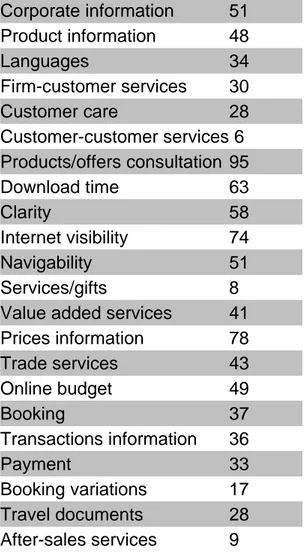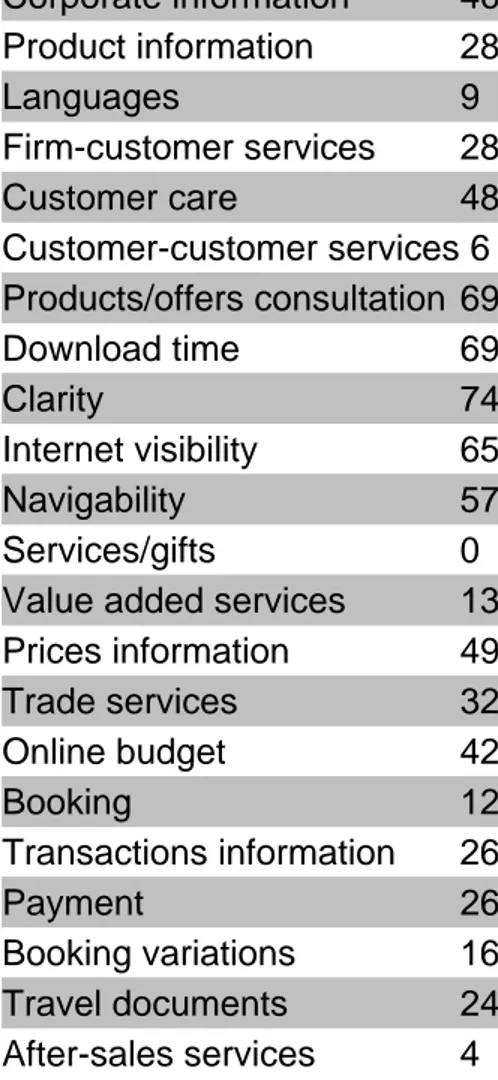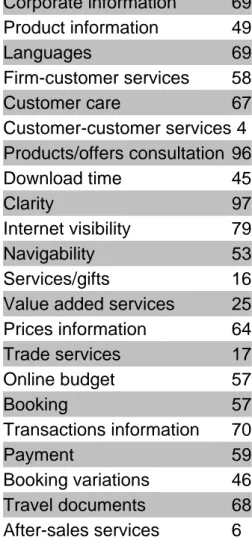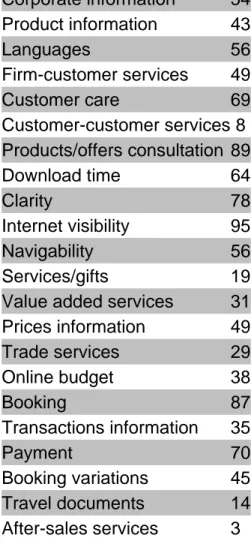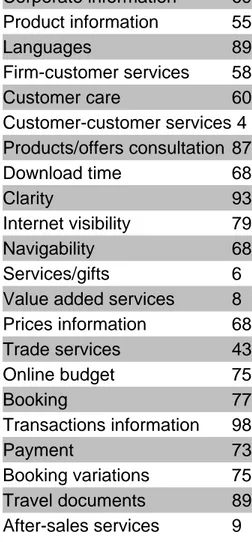How Are The Operators In The Tourism Industry
Approaching The Virtual Channel
Michelle Bonera*
This paper reports on the findings of a research on the Web strategy and efficacy of different kind of firms operating in the tourism industry. The study has been conducted considering European companies. In this article we investigate the value chain of the tourism industry. The aim is to understand which organizations are the most prepared to use the real oportunities offered by the virtual channel. For example travel agencies are using the Web site as a communication tool, and hotels are using it to market goods and services, to receive reservations, and to evacuate customer complaints or suggestions.
Field of Research: Tourism marketing, Web marketing
1.0 Introduction
Tourism is one of the world’s most important industries, in its simplest form, the chain members of the tourism industry include the destination service providers, the inbound tour operators, the outbound tour operators and the local travel agents (Figure 1).
Figure 1 - Tourism industry value chain
Over the last few years tourists are traveling more frequently, but for shorter periods. They request more specialized trips, and have higher expectations in terms of convenience, value and customization.
________________
* Michelle Bonera, Researcher di Economia e Gestione delle Imprese, Università degli Studi di Brescia, [email protected]
destinations
158 Consumers are developing a self-service mentality, beeing more knowledgeable, and more accustomed to automation. They look for market transparency, service quality and global advice. There have been two main trends in consumer marketing, the relationship marketing and the customer equity. The first has led to encouraging the customer to make repeat purchases through understanding the needs of the customer and customizing the offering. The second has led towards experience marketing, the customer becomes a part of the experience and the marketer wants to engage all five senses of the customer. Tourism has been an early adopter of new technologies (Bloch, 1996). They had an important role in the touristic development as a growth facilitating factor. Tourism services have emerged as a leading category to be promoted and distributed through the Web. The aim of the paper is to understand which organizations are the most prepared to use the real potencialities offered by the virtual Internet.
2.0 Literature Review
In light of the trends observed in the industry and the opportunities presented by e-commerce, it is likely that the growth of the Internet as a medium in the tourism industry will have a strong impact. The physical activities surrounding the tourist experience will not fundamentally change. Technology will increasingly improve the experience, the efficiencies and services and reduce the costs. Products and prices can be compared on the Web and lots of information can quite easily be obtained. Competitors abound and all are equidistant a mere mouse click away. The “Death of Distance” describes how the Internet can eliminate the barriers caused by distance while the “Homogeneity of Time” refers to the ability of virtual businesses to operate 24 hours a day 365 days a year.
The tourism market is increasingly organized on a global level and this is reinforced by the use of the Internet, which is a medium that has no geographical boundaries. Unlike most other industries, the physical distance between suppliers and consumers cannot be changed. However the distance between tourists and touristic destinations has led to the development of the value chain and its numerous and specialized intermediaries. Inbound tour operators needed to be close to the supplier, travel agents were close to the customer and the outbound tour operators provided the link across geographical boundaries. A single intermediary can undertake all activities in the virtual value chain, because a travel location on the Web is as close to a customer in every part of the world.
159 Internet can directly link suppliers and customers and hence the potential to cause mass disintermediation in the value chain. In fact the first actors to launch on line ventures were focused on disintermediation. However, the Web does not remove the need for intermediaries. Some customers, if not most, will want and will accept to pay for the level of service that comes from using an intermediary, who will provide them with its experience in order to save them money and time (Bloch and Segev, 1996). Just as in the physical world, customers do not want to deal with the difficulty of contacting many suppliers, comparing their offers and buying single services. Bloch et al. (1996) suggest that potential tourists face a wide range of difficulties when trying to book directly in the suppliers’ web sites. They require, for example, knowledge of where to search for the destination sites. Than it takes much time to visit each destination site to view the information needed. Often different sites present information in different formats and it is difficult to make a valid comparisons. Sometimes, it is not possible to book online. In addition, the product cannot be tried or even seen before purchase, and a healthy scepticism about the trustworthiness of the companies and offers is natural. There is an important opportunity for those who are considered experts to support the decision-making process. Since most customers are first-time visitors, individual destination service providers are not in a position to benefit from the ability the Internet provides to build up customer profiles. However, intermediaries can potentially build up very detailed customer profiles. It should be evident that mass disintermediation is highly unlikely in this industry. Intermediaries which add real value with their expertise and service will remain relevant and be successful.
On the other hand, it is almost certain that new virtual intermediaries will develop. Moreover free information will reduce the power of the current intermediaries and could remove the advantages of proprietary networks such as computer reservation systems (Bloch and Segev, 1996). Internet could render many intermediaries obsolete, while simultaneously creating new ones. The varying needs and buying behaviours of tourists are one of the reasons for the complex nature of the traditional distribution chain. In the virtual realm, it is possible to customize the buying process to the needs of each customer. Bloch (1996) identifies the Internet shopping malls (e.g. Travelocity, Expedia) as the future industry magnets. These organizations have both evolved from computer reservation systems.
Internet offers great flexibility for tourism suppliers operating in volatile markets. The offer can be changed much more quickly than with print documents. The searching of information, the choice of destinations and
160 arranging of reservations are all activities that can be done far more easily on the Web than through printed brochures. Touristic products are suitable for the Internet also because the hyper textual and multimedia communication is perfect to describe such complex products. E-commerce can handle clearance of perishable capacity close to the time of use and for manage yields effectively (Wolff, 1997; Connolly et al., 1998). Customers gain greater choice, multi-sensory, accurate and up-to-date information, immediate gratification of their requests and an easy to use interface (Pollock, 1996). The information costs are reduced for customers and travel agents and the wide diversity of information can be represented on one terminal (Bakos, 1991). There will definitely be opportunities for suppliers to add new value in the virtual realm. The Web allows the creation of a stable relation between supplier and the customer. The Internet is also an inexpensive and effective way to carry out market research (Franch, 1999). Those firms that concentrate on providing good service, managing the tourist experience will be the most successful.
3.0 Methodology of The Study
The first phase of the research was the sample selection of the tourism organization’s Web sites using the Nielsen//NetRatings list of the most viewed ones in the 2004 a Databank study on tourism Web sites and a survey conducted by The Economist. The analysis has been conducted on a sample of 426 European Web sites.
They were included in five different clusters: 1. tour operators, inbound and outbound;
2. traditional travel agents operating both on and off line; 3. virtual travel agents operating only through Internet; 4. hotel chains;
5. transportation providers (airlines, train companies).
Than we selected 104 items in order to evaluate the Web sites quality and efficacy. These items referred to the following categories:
• the corporate information, concerns for example the organization chart, the company history, company mission and vision;
• the product information, related to the quantity and quality of the information given;
161 • the firm-customer services, like a newsletter, a chat with an employer
and the frequently asked questions;
• the customer care services, like the toll free number or the call centre; • the customer-customer services, for example the guest-book or a
forum;
• products/offers consultation, it refers to the easiness of the process, the time and the number of click needed;
• download time, related to the main information; • clarity of the text contained;
• internet visibility, referring to the results of some keywords researches made using Google’s research engine;
• navigability, given by the structure and paths of the Web sites;
• services/gifts at disposal like screensaver, e-cards and electronic games;
• value added services, such as weather information and currency exchange rates;
• prices information and special offers;
• services for the trade channel, for example tools to search the trade operators location;
• online budget, it provides the possibility to check the service availability;
• on line booking service;
• transactions information and payment choice also related to its safety; • payment process;
• booking variations, it concerns the possibility to follow a standard process to change the booking conditions;
• travel documents, can be delivered on or off line;
• after-sales services, like the customer care survey or the customer evaluation of the service directly on the Web site.
The Web sites observed in the analysis obtained two points for each functioning item recognized, one point for the incomplete or not up-to-date items and zero points for the total absence of the items.
4.0 Discussion of Findings
We noticed that in some cases, especially in the Italian market, the tour operators choose not to cannibalize their off line distribution channel and use their Web site only to give information or for branding purposes. They offer some on line services like the possibility to check the service availability but
162 they don’t let the on line booking. In fewer cases, especially in the USA market, the tour operators use their Web site as a direct selling channel. The main purpose of these Web sites is to provide information facilitating the choice process. Not many services are supplied showing the diffused inadequacy to create a long time relation with the customers.
Figure 3 – Tour operators’ Web site features (%) Corporate information 51 Product information 48 Languages 34 Firm-customer services 30 Customer care 28 Customer-customer services 6 Products/offers consultation 95 Download time 63 Clarity 58 Internet visibility 74 Navigability 51 Services/gifts 8
Value added services 41 Prices information 78 Trade services 43 Online budget 49 Booking 37 Transactions information 36 Payment 33 Booking variations 17 Travel documents 28 After-sales services 9
163 As to the traditional travel agencies, the Internet preparation is generally low. The marketing strategies and policies used on line are similar to the off line ones. The information potential is even lower than the previous cluster.
Figure 4 – Traditional travel agencies’ Web site features (%) Corporate information 46 Product information 28 Languages 9 Firm-customer services 28 Customer care 48 Customer-customer services 6 Products/offers consultation 69 Download time 69 Clarity 74 Internet visibility 65 Navigability 57 Services/gifts 0
Value added services 13
Prices information 49 Trade services 32 Online budget 42 Booking 12 Transactions information 26 Payment 26 Booking variations 16 Travel documents 24 After-sales services 4
Obviously, virtual travel agencies seem to be more prepared and Web oriented. The majority of the Web sites considered are e-commerce sites and
164 many of them adopt more aggressive marketing policies. For example some provide dynamic packaging and service personalization.
The services provided and the site interactivity lead to a tighter relation with the customers. Much attention is also paid to the Internet visibility.
Figure 5 – Virtual travel agencies’ Web site features (%) Corporate information 69 Product information 49 Languages 69 Firm-customer services 58 Customer care 67 Customer-customer services 4 Products/offers consultation 96 Download time 45 Clarity 97 Internet visibility 79 Navigability 53 Services/gifts 16
Value added services 25
Prices information 64 Trade services 17 Online budget 57 Booking 57 Transactions information 70 Payment 59 Booking variations 46 Travel documents 68 After-sales services 6
The hotel chains show great interest for the Internet selling channel and adopt generally an active role. They know that disintermediation can be very profitable and try to invest in the on line and off line visibility.
165 Usually they use the Web to implement a low price policy but they also pay attention to the services provided.
Figure 6 – Hotels’ Web site features (%)
Corporate information 54 Product information 43 Languages 56 Firm-customer services 49 Customer care 69 Customer-customer services 8 Products/offers consultation 89 Download time 64 Clarity 78 Internet visibility 95 Navigability 56 Services/gifts 19
Value added services 31
Prices information 49 Trade services 29 Online budget 38 Booking 87 Transactions information 35 Payment 70 Booking variations 45 Travel documents 14 After-sales services 3
For transportation providers the main benefit of the Internet is the widespread distribution of the tickets. Furthermore they tend to offer a wide range of related tourism services on their Web sites that appear similar to tourism portals. In many cases they often permit the hotel research and booking.
166 Like the hotel’s chains they usually prefer a pull strategy to obtain a cost cut. At present the airlines companies are the better examples of low price policies.
Figure 7 – Carriers’ Web site features (%)
Corporate information 69 Product information 55 Languages 89 Firm-customer services 58 Customer care 60 Customer-customer services 4 Products/offers consultation 87 Download time 68 Clarity 93 Internet visibility 79 Navigability 68 Services/gifts 6
Value added services 8
Prices information 68 Trade services 43 Online budget 75 Booking 77 Transactions information 98 Payment 73 Booking variations 75 Travel documents 89 After-sales services 9
5.0 Conclusion
Internet, definitively, provides an important distribution channel for the tourism industry and induces to the establishment of a virtual value chain. Clearly, such developments imply significant threats for those organizations
167 in the current value chain. In order to take advantage of the positive aspects presented by the Web and the marketing trends, successful intermediaries will have to offer complete services that allow customers to make all their travel decisions and bookings in one site and they will have to maintain a database that will allow them to build up an accurate and up to date profile of each tourist. Finally they will have to use this to customize the services to each customer. In order to do so they will have to aggregate information and specialized knowledge in a single format at a single virtual destination. They will also need to routines transactions in order to provide a single integrated reservation system that lets customers to book all parts of their travel in a single step and permits customization by offering the customer the possibility to create his own itinerary. They will have to permit easy comparisons by offering information in a uniform way, giving access to all the comments made by previous tourists. Since the Web transcends physical location and boundaries, intermediaries will also have to transcend physical location. Outbound tour operators are, till now, probably the most endangered intermediaries. Their activities are mostly virtual ones and as such are better suited to the Web. Inbound tour operators and destination service providers will have to concentrate on their physical value chains and leverage their great expertise of local markets. They will be able to differentiate themselves by their service quality and by creating new and strong experiences. The central concern for travel purchasers must be, more than ever, trust. They must, however, either attempt to become an industry magnet or join forces with one. They will gain greater benefit by joining an Internet tourism mall than by trying to bypass the industry magnet. Finally, they will benefit from the reduced number of intermediaries, both because of the global attitude of the Web travel malls and the lower transaction costs of the Internet.
Several authors (Bloch, 1996, Verity, Hoff, 1994) have shown also travel agents must rethink themselves and leverage their strength: supplier offerings, personal knowledge of their consumers and travel market. They have the chance to try to become an industry magnet. This requires many monetary resources, a strong technical expertise and massive promotion. They can also reposition themselves as travel management consultants, assisting customers with personalized service and support. Obviously, they can also gain a new competitive advantage by improving the real world purchasing experience.
168
6.0 References
Adrian Palmer and Patrick McCole 2000. “The role of electronic commerce in creating virtual tourism destination marketing organizations”
International Journal of Contemporary Hospitality Management 12/3
198-204.
Alderson, W. 1958. “Factors governing the development of marketing channels”, in Clewett, R.M. (Ed.), Marketing Channels for Manufactured Products, Richard D. Irwin, Homewood, IL.
Berthon, Pierre and Pitt, Leyland and Watson, Richard T., 1996. “The world wide Web as an Advertising Medium” Journal of Advertising
Research, Jan/Feb., 43-55.
Bloch, M. and Segev, A. 1996. “The Impact of Electronic Commerce on the Travel Industry”. http://haas.berkley.edu/~citm.
Bloch, M., Pigneur, Y. and Steiner, T. 1996. “The IT-enabled Extended Enterprise, Applications in the Tourism Industry”, http://haas.berkley.edu/~citm.
Buhalis D. 2003. eTourism: Information Technology for Strategic Tourism
Management, Harlow: Prentice Hall.
Casarin F. 1996. Il marketing dei prodotti turistici. Specificità e varietà, Torino, G. Giappichelli Editore.
Connolly, D.J., Olsen, M.D. and Moore, R.G. 1998. “The Internet as a distribution channel”, Cornell Hotel and Restaurant Administration
Quarterly, Vol. 8 No. 4, pp. 42-54.
Guerini C., Franchini A. 2000. “Il ruolo di Internet nel marketing dei servizi : verso il prodotto virtuale”, Liuc papers, Castellanza.
Mandelli A., Vescovi T. 2003. Le nuove frontiere del marketing digitale, Etas, Milano
Martini U. 2000. “L’impatto di Internet sulla struttura del mercato turistico leisure”, Technical Report DISA, Quaderno n. 36, Ottobre 2000.
Martini U., Jacucci G., Calzà D., Cattani C. 2000. “Mentoring Small Destinations into Destination Management towards Electronic Marketing”, in ENTER2000 Conference Proceedings, Vienna, SpringerComputerScience.
169 Millman, H. 1998. “Online travel arrangements begin to catch on”, Infoworld,
Vol. 20 No. 9, p. 78.
Pollock, A. 1995. “The impact of information technology on destination marketing”, EIU Travel and Tourism Analyst, No. 3, pp. 66-83.
Quelch, J. A., and Klein, L. R. 1996. “The Internet and International Marketing”, Sloan Management Review, Spring, 60-75.
Rayport, J.F. and Sviokla, J.J. 1996. “Exploiting the virtual value chain”, The
McKinsey Quarterly, No. 1.
Stern, Louis W. and Adel I. El-Ansary 1988. Marketing Channels, Englewood Cliffs, Prentice Hall, NJ.
Stipanuk D.M. 1993. “Tourism and Technology. Interactions and Implications”, in Tourism Management, August.
Sussmann, S. and Baker, M. 1996. “Responding to the electronic marketplace: lessons from destination management systems”,
International Journal of Hospitality Management, Vol. 15 No. 2, pp.
99-112.
Verity J. & Hof R. 1994. “The Internet: How it will change the way you do business” Business Week, 14 November.
